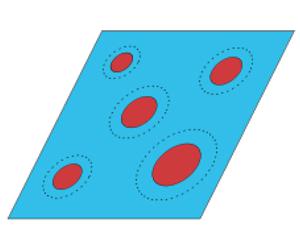Journal of Fluid Mechanics ( IF 3.7 ) Pub Date : 2020-06-09 , DOI: 10.1017/jfm.2020.379 Christoph Kammer , Pedro Ponte Castañeda

|
This work is concerned with the oscillatory rheology of non-colloidal suspensions of highly deformable viscoelastic particles in Newtonian fluids under simple shear loading. To this end, use is made of the homogenization model of Avazmohammadi & Ponte Castañeda (J. Fluid Mech., vol. 763, 2015, pp. 386–432) accounting for the time evolution of the average particle shape and orientation. For small excitation amplitudes, the equations reduce to the small-strain Oldroyd model with expressions for the storage and loss moduli,  $G^{\prime }$
and
$G^{\prime }$
and  $G^{\prime \prime }$
, that recover those of Roscoe (J. Fluid Mech., vol. 28 (2), 1967, pp. 273–293) for small particle concentrations. However, at sufficiently large concentrations,
$G^{\prime \prime }$
, that recover those of Roscoe (J. Fluid Mech., vol. 28 (2), 1967, pp. 273–293) for small particle concentrations. However, at sufficiently large concentrations,  $G^{\prime }$
and
$G^{\prime }$
and  $G^{\prime \prime }$
may intersect, such that
$G^{\prime \prime }$
may intersect, such that  $G^{\prime }>G^{\prime \prime }$
in a given frequency range. In the large amplitude oscillatory shear (LAOS) regime, the behaviour of
$G^{\prime }>G^{\prime \prime }$
in a given frequency range. In the large amplitude oscillatory shear (LAOS) regime, the behaviour of  $G^{\prime }$
and
$G^{\prime }$
and  $G^{\prime \prime }$
with increasing strain amplitude is consistent with type I or type III behaviour, in the terminology of Hyun et al. (J. Non-Newtonian Fluid Mech., vol. 107 (1–3), 2002, pp. 51–65), depending on the particle properties and concentration. In addition, the rheology is characterized by means of stress waveforms and Lissajous–Bowditch cycles in a Pipkin diagram. By accounting for the microstructure evolution, the model captures a number of nonlinear features commonly observed in the LAOS rheology of complex fluids, including a variety of distorted stress waveforms that manifest themselves in complex intracycle behaviour, as well as secondary loops. Furthermore, as a consequence of directional biases associated with the large deformations of the particles, the model predicts non-vanishing normal stress differences whose characteristic limit cycles are also presented in Pipkin space and reveal the formation of secondary loops for suspensions of Gent particles. However, it should be emphasized that the sources of these nonlinear rheological features for soft particle suspensions are very different from those for rigid particle colloidal systems and, in contrast to the colloidal systems, manifest themselves at dilute volume fractions of the particles.
$G^{\prime \prime }$
with increasing strain amplitude is consistent with type I or type III behaviour, in the terminology of Hyun et al. (J. Non-Newtonian Fluid Mech., vol. 107 (1–3), 2002, pp. 51–65), depending on the particle properties and concentration. In addition, the rheology is characterized by means of stress waveforms and Lissajous–Bowditch cycles in a Pipkin diagram. By accounting for the microstructure evolution, the model captures a number of nonlinear features commonly observed in the LAOS rheology of complex fluids, including a variety of distorted stress waveforms that manifest themselves in complex intracycle behaviour, as well as secondary loops. Furthermore, as a consequence of directional biases associated with the large deformations of the particles, the model predicts non-vanishing normal stress differences whose characteristic limit cycles are also presented in Pipkin space and reveal the formation of secondary loops for suspensions of Gent particles. However, it should be emphasized that the sources of these nonlinear rheological features for soft particle suspensions are very different from those for rigid particle colloidal systems and, in contrast to the colloidal systems, manifest themselves at dilute volume fractions of the particles.
中文翻译:

大振幅振荡剪切作用下高变形颗粒分散体流变学的理论预测
这项工作涉及牛顿流体中在简单剪切载荷作用下高度变形的粘弹性颗粒的非胶体悬浮液的振荡流变学。为此,使用了Avazmohammadi和PonteCastañeda的均质化模型(J. Fluid Mech。,第763卷,2015,第386-432页),说明了平均颗粒形状和取向的时间演化。对于较小的激励振幅,方程式简化为小应变Oldroyd模型,其具有存储和损耗模量
$ G ^ {\ prime} $
和
$ G ^ {\ prime \ prime} $的
表达式,它们恢复了Roscoe(J. Fluid Mech。,第28卷,第2卷,1967年,第273-293页)。但是,在足够大的浓度下

 $ G ^ {\ prime} $
和
$ G ^ {\ prime \ prime} $
可能相交,使得
$ G ^ {\ prime}> G ^ {\ prime \ prime} $
在给定的频率范围内。在大振幅振荡剪切(LAOS)方案中,术语
$ G ^ {\ prime} $
和
$ G ^ {\ prime \ prime} $
的行为随着应变幅度的增加而与I型或III型行为一致。玄等。 (J.非牛顿流体力学。
$ G ^ {\ prime} $
和
$ G ^ {\ prime \ prime} $
可能相交,使得
$ G ^ {\ prime}> G ^ {\ prime \ prime} $
在给定的频率范围内。在大振幅振荡剪切(LAOS)方案中,术语
$ G ^ {\ prime} $
和
$ G ^ {\ prime \ prime} $
的行为随着应变幅度的增加而与I型或III型行为一致。玄等。 (J.非牛顿流体力学。


 ,卷 107(1-3),2002,第51-65页,取决于颗粒的性质和浓度。另外,流变学的特征是通过在Pipkin图中的应力波形和Lissajous-Bowditch循环。通过考虑微观结构的演化,该模型捕获了在复杂流体的LAOS流变中通常观察到的许多非线性特征,包括在复杂的周期内行为和次级回路中表现出来的各种扭曲的应力波形。此外,由于与粒子的大变形有关的方向偏差,该模型预测了不消失的法向应力差,其特征极限环也出现在皮普金空间中,并揭示了根特粒子悬浮液的次级回路的形成。然而,
,卷 107(1-3),2002,第51-65页,取决于颗粒的性质和浓度。另外,流变学的特征是通过在Pipkin图中的应力波形和Lissajous-Bowditch循环。通过考虑微观结构的演化,该模型捕获了在复杂流体的LAOS流变中通常观察到的许多非线性特征,包括在复杂的周期内行为和次级回路中表现出来的各种扭曲的应力波形。此外,由于与粒子的大变形有关的方向偏差,该模型预测了不消失的法向应力差,其特征极限环也出现在皮普金空间中,并揭示了根特粒子悬浮液的次级回路的形成。然而,



























 京公网安备 11010802027423号
京公网安备 11010802027423号